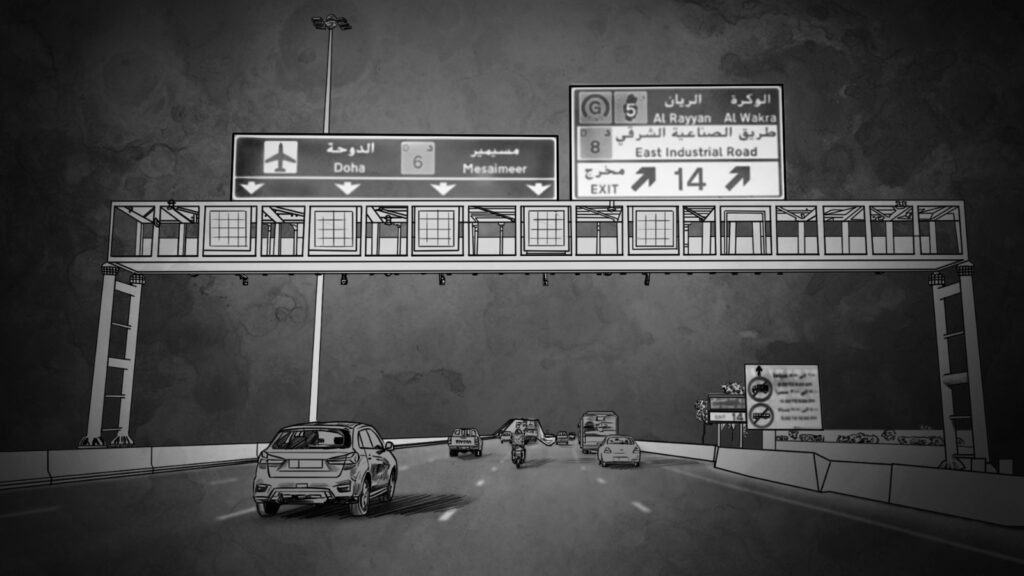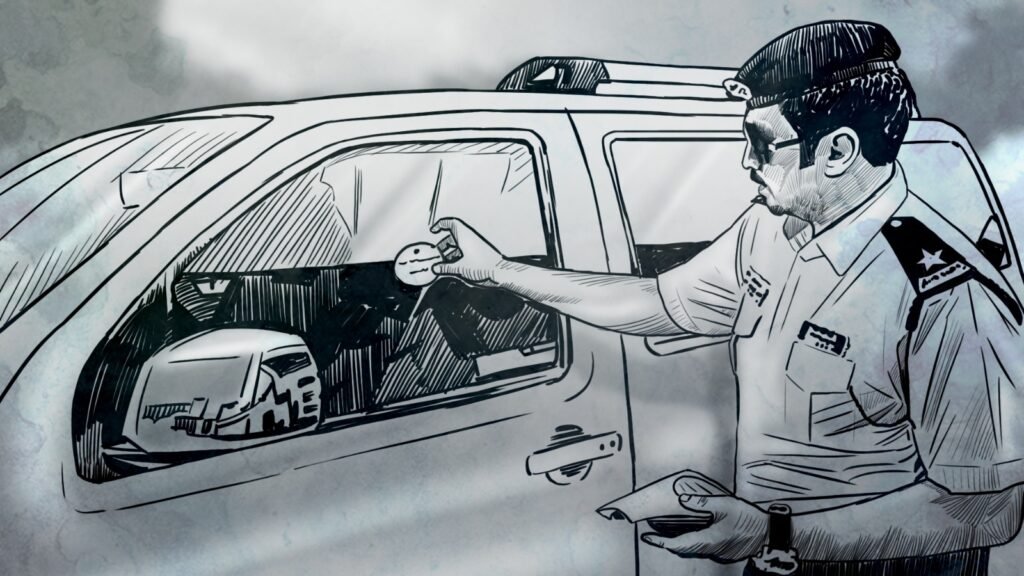Transportation is one of the most important human inventions. Walking and riding horses and animals are among the oldest means of transport used by humans. With technological, industrial, and innovative advancements, these means have evolved, making travel between cities and countries easier, more convenient, and faster than ever before.
The Beginning
In 1885, Carl Benz manufactured the first gasoline-powered car, and by 1914 the number of cars had reached over five hundred thousand, making automobiles a significant part of daily life and opening a new era in transportation and communication.
With this development and expansion came the problem of traffic accidents, which all countries began to suffer from as they increased day by day, causing many human fatalities and disabilities, not to mention financial losses.
From this standpoint, it became imperative for countries to adopt a comprehensive road system to ensure safe transportation for all its users, and to accommodate all the new developments and challenges in this field.
Thus, roads began to take on new forms suitable for the modern transportation system and traffic flow, including paved streets, bridges, tunnels, lanes, and designated parking areas for these vehicles.
It was necessary to regulate traffic on various streets and roads to facilitate movement and prevent potential accidents, leading countries to develop plans and laws to ease traffic flow and reduce accidents or traffic jams, to prevent traffic from becoming as chaotic as bumper cars in an amusement park.
Driving a car requires driver efficiency, as well as legislation from countries that continuously adapt road building, internationally coordinated and agreed upon. The expansion in car traffic led to several agreements, the most notable being the 1968 Vienna Convention on Road Traffic.
The convention addressed several issues including traffic rules, traffic signs, road infrastructure, and periodic technical inspections of vehicles and their fitness for use. It required registration plates to identify different vehicles, aiming to enhance safety and reduce the number of collisions and casualties, and to implement road traffic policies and facilitate movement.
This convention was widely adopted and remains in effect to this day, gaining significant importance. Notably, in October 2022, 86 countries signed this convention, including Qatar, as stated in Decree No. (40) of 2022, with a reservation regarding the article on recourse to the International Court of Justice.
Since the inception of these agreements and meetings, we have witnessed many developments in road traffic regulation, where countries began deploying traffic police at intersections, set appropriate speed limits on roads, and installed signs and signals. This includes traffic awareness campaigns to instill proper traffic culture among individuals.
Subsequently, methods for organizing traffic gradually evolved until technology entered to facilitate the work of traffic police. Traffic lights were installed, and cameras and radars were placed to limit speeding in various streets and roads. Laws and legislations were enacted to regulate traffic and improve the behaviors of vehicle drivers.
Regulating traffic flow on roads is crucial to prevent numerous potential issues that could result in loss of life and property. When some drivers neglect traffic laws, engaging in reckless driving and violating rules designed to protect people and property, it results in an unrelenting daily war on the roads—a war that a driver wages against themselves and other road users, with their vehicle as their weapon. What, for instance, is the difference between someone who fires a gun randomly and someone who runs a red light and collides with a school bus?
Consequently, states have compelled road users to adhere to traffic laws, or else face the consequences of violations.

Traffic Penalties
Sheikh Abdul Qadir Sheibah Al-Hamd defined the term violation on his official website as “what contradicts the explicit ruling, also called the evidence of discourse, and may be defined as using the specificity of something mentioned to negate the ruling on everything else.”
Contemporary scholars, including researcher Muhammad Hamd Abdul Hamid, have provided many definitions in his research paper titled The Meaning of Violation Among the Scholars of Principles and its Applications in Jordanian Law. One of the definitions by Muhammad Adib Al-Saleh states, “It is the implication of a phrase that establishes a ruling for what is not mentioned, contrary to what the explicit words indicate due to the absence of a condition considered in the ruling.”
The legal glossary defines a violation as “a minor legal breach or a violation of a contract or agreement or right, not considered a misdemeanor or felony, and not punishable by imprisonment, such as traffic law violations which fall into this category.”
This definition is observable in Qatari Law No. (11) of 2004, which classifies the type of crime according to the maximum penalty prescribed by law, as indicated in Article 21;
felonies must have a prison sentence of no less than three years, “crimes punishable by death or life imprisonment, or imprisonment exceeding three years, unless otherwise stated by law.”
Misdemeanors are “crimes punishable by imprisonment not exceeding three years and a fine exceeding one thousand Riyals, or by community service, or one of these punishments, unless otherwise stated by law.”
Traffic violations in Qatar, such as speeding, failing to comply with traffic signals, and improper overtaking, fall under the previously mentioned definitions, classified according to their severity, divided into minor and major penalties.
It is a misconception that only traffic departments are responsible for marking violations; although they play a major role due to their extensive experience in this sector, other entities are also responsible for setting violations. For instance, Traffic Law No. (19) of 2007, which includes eight chapters and 106 articles.
Chapter Seven dedicated to penalties ranging from one month to three years in prison and fines from 10,000 to 50,000 Riyals for some violations, imposes mandatory harsher penalties for repeat offenders. Some provisions indicate milder penalties and smaller fines for other violations, with increased penalties for repeat offenders, and some reaching to the revocation of driving licenses, emphasizing strict enforcement and compliance with traffic laws.
The comprehensive Qatari Wiki encyclopedia lists many traffic violations in Qatar and their penalties.
It is also noteworthy that the Gulf Cooperation Council countries enacted a unified traffic system law, approved in Riyadh in 1989 by their Highnesses and Excellencies, the Ministers of Interior at their eighth meeting, as a guiding system to be reassessed after three years, with member states that follow it to notify the General Secretariat.
During this period, it was evident that member states followed this system when issuing or amending their traffic regulations, and the final version of the system referred to was adopted in the twenty-eighth meeting organized in Muscat in 2009, to be reviewed after three years.

Traffic Safety
The second chapter of the Qatari Constitution emphasizes the state’s commitment to the care and safety of its citizens, as Article 22 stipulates the need to “protect them from physical, mental, and spiritual neglect.” Therefore, traffic safety is considered an aspect of this care, and it is the responsibility of Qatar’s General Directorate of Traffic and the Ministry of Interior to achieve this goal through departments that take technological and technical developments into account.
The Qatar News Agency reported that Major General Abdulaziz bin Jassim Al Thani mentioned that one of the goals of the Gulf Traffic Week in March 2024 is to highlight the dangers of using mobile phones while driving, noting that this behavior is one of the leading causes of traffic accidents not only locally but globally.
This type of event and related exhibitions and awareness activities “call for adherence to traffic laws and etiquette, and compliance with traffic safety requirements, to enhance road security and protect lives and property,” added Major General Al Thani. He noted that the Traffic Department recently installed advanced cameras that can capture images of three violations at once: speeding, not wearing a seatbelt, and using a mobile phone while driving, with fines imposed to curb its use. Mobile devices are among the leading causes of many accidents and fatalities on the roads.
A prominent example of traffic violations being an effective solution for raising awareness and reducing risks is the law regarding mobile phone use. Decree-Law No. (19) of 2007 issuing the Traffic Law prohibits “the use of mobile phones or other devices in any way while driving, using one’s hand to hold or use them,” but some drivers did not heed this law until the traffic violation fine of five hundred riyals was legislated.
Arab Newspaper quoted Captain Mohammed Rabia Al Kuwari stating in the Qatar Radio program “Police With You” that there is absolutely no leniency for mobile phone use while driving, with no possibility for any discounts on its penalty, revealing that using the phone leads to traffic accidents ranging from 50 to 60%.
Thus, it is evident that traffic violation penalties are a means, not an end, aimed at reducing violations and serving as a deterrent to preserve lives, as some people do not respond to advice or words, but only to the financial impact of fines.




